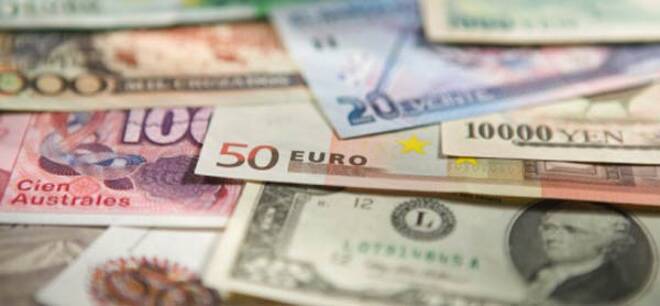Advertisement
Advertisement
How to Trade Using the Carry Trade Strategy
By:
Intro
The carry trade has been a particularly popular medium to long-term strategy within the FX world. Carry trades and interest rates differentials provide the volatility in the FX market and more importantly, provide the opportunity for a trader to execute a carry trade, with high odds of a positive return.
Carry trade is the borrowing or selling of a financial instrument with a low-interest rate, then using it to buy another instrument with a higher interest rate. The trades will either be going short on the lower interest rate currency or going long on the higher interest rate currency, with the carry trades needed to be held for a prolonged period of time using leverage for enhanced returns and take advantage of interest rates spread between the two currencies.
The use of leverage with a broker to increase earnings multiples through interest rate arbitrage is considered to be a ‘risk on’ strategy, where investors will either consider the current economic environment to be positive for their position or, more importantly, for the economic outlook to be positive, supporting an interest rate diverging environment that enhances carry trade returns. The strategy is based on the evaluation of the economic situation of each country or financial zone.
Risk Aversion – How to Trade the Carry Trade?
The carry trade has been a particularly popular medium to long-term strategy within the FX world, with shifts in interest rates tending to be few and the opportunity to take long-term positions to appeal to investors and hedge funds.
Basically, carry trade is all about the interest rates differentials, and, more importantly, interest rates prediction.
Yet, for the retail investors, cautions must be taken into the account. While in an ideal world, where political stability persists and macroeconomic conditions have been supportive of carry trades, it is not always as simple as moving from a low yielding to a high yielding environment.
Economic shocks will be reflected within the FX world, sometimes far more quickly than in other asset classes.
Additionally, while central banks have a tendency to provide guidance for the financial markets, supposedly giving ample time to respond and position in anticipation of a shift in policy, some central banks are less interested in forwarding guidance than other. A surprise shift in policy by a central bank capable of eroding any returns made through a carry trade on a given day and even lead to heavy losses.
Risk aversion can also come about from natural disasters or war and not just from a shift in the policy outlook.
In summary, key risks to carry trade positions include:
- Geo-Political Risk – A political event that will influence sentiment towards monetary policy and economic outlook for a given country, such as Brexit, sanctions, trade war and more.
- FX risk – returns from interest rate differentials offset by exchange rate movements in the carry trade, leading to losses in spite of interest rate differentials favoring the carry trade.
- Gearing risk – Losses resulting from unexpected movements that are exasperated by leveraged positions that could result in margin calls or even positions being stopped out by an exchange.
- Interest Rate Risk – More of an issue when including compounding interest. Movements in interest rate differentials can have a positive or negative impact on returns, with a narrowing in differentials leaving returns lower than expected until the next interest compounding period.
And yet, although risk aversion can be a risk for carry trades positions, carry trades can come as a smart decision for a long-term investment or a trigger to buy/sell any instrument.
The most traditional carry trades have been the USD/JPY, the NZD/USD, NZD/JPY, AUD/USD and the AUD/JPY, with the EUR/USD coming into its own since the global financial crisis. There are others, including the Brazilian real and the Turkish Lira, with some more volatile exotics also on offer, but risk appetite will need to be particularly high and with some economies less transparent than others, carry trades into such exotic currencies come with significant risk. Although these pairs are at the highest level of popularity when it comes to carry trades, any currency or currency pair can be considered a carry trade transaction.
Interest rates spread between two countries can be the main catalyst for a strength of one currency over another currency.
Looking at today’s interest rate environment, the EUR and the Japanese Yen are amongst the preferred funding currencies, with interest rates sitting at or below 0%.
When looking at the recent moves in yields for 10-year U.S Treasuries, the material shift in sentiment towards the U.S economy and monetary policy outlook has seen the Dollar rally of late, with year-to-date losses having been all but wiped out in just a matter of weeks.
For those looking to take on carry trades, finding the right trading platform that offers the appropriate trading tools is key. HQBroker is one such platform that offers the trading of FX and CFDs, giving the trader the option to scalp, swing or take on longer-term positions that includes carry trades, with the use of leverage to enhance returns.
Every trader must research and understand the significance of carry trades prior to entering a transaction and at the exit of the transaction. Carry trades and interest rates differentials provide the volatility in the FX market and more importantly, provide the opportunity for a trader to execute a carry trade, with high odds of a positive return.
About the Author
Bob Masonauthor
With over 28 years of experience in the financial industry, Bob has worked with various global rating agencies and multinational banks. Currently he is covering currencies, commodities, alternative asset classes and global equities, focusing mostly on European and Asian markets.
Advertisement
Table of Contents
Advertisement
Advertisement
Advertisement
Advertisement
